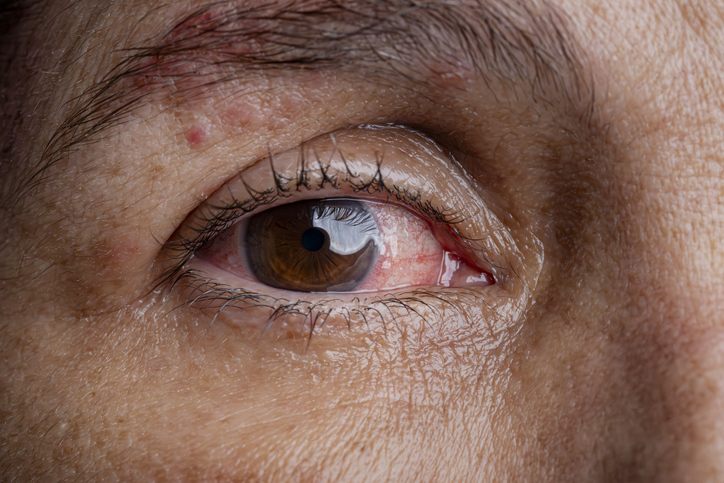Diseases
Ophthalmic shingles

Definition
This viral eye disease is caused by reactivation of the varicella-zoster virus, which causes chickenpox. When a person is infected, the then-latent virus remains in the body, at the nerve root, but it can sometimes become reactivated, notably as a result of weakened immunity due to aging. When the virus reactivates, it spreads to the skin, causing a condition known as “shingles”. If it reaches the forehead or nose, it's not uncommon for the eye to become infected too: this is known as “ophthalmic shingles”.
Symptoms
The first symptoms are pain or tingling, which may occur on the forehead. The skin is then covered with small red blisters that hurt like hell. When it spreads to the eyes, the virus causes painful infection, redness, sensitivity to light and swelling of the eyelids. Sometimes, the cornea is also infected and inflamed, which can make it insensitive and highly vulnerable to all kinds of damage. Months or years later, the cornea can become severely damaged. Finally, ophthalmic shingles can also be responsible for the onset of uveitis, an inflammation of the structures behind the cornea, or glaucoma, due to increased pressure in the eye.
Diagnosis
Diagnosis is based on a clinical examination by a physician. The presence of active shingles with manifestations such as a rash on the face, first vesicular then crusty, or a history characteristic of this pathology, are factors helping the diagnosis.
Prevention
The only way to prevent this disease is through vaccination. It is recommended that healthy people over the age of 65 (or over 50 if immunosuppressive treatment is planned in the near future) be vaccinated against shingles. The vaccine is over 90% effective.
The presence of active shingles with manifestations such as a rash on the face, first vesicular then crusted, or a history characteristic of this pathology, are factors helping in the diagnosis.
Treatments
The first treatment for ophthalmic shingles, as for shingles anywhere else on the body, is medication. An early oral antiviral treatment reduces the duration of the painful rash and the risk of ocular complications. Corticosteroid eye drops may also be necessary if the eye is severely inflamed. Finally, if a severe form of glaucoma is at risk of developing, eye drops specifically designed to keep the pupil dilated are prescribed.
Frequency
In Switzerland, over 99% of the population has been in contact with the varicella-zoster virus up to the age of 40. Its prevalence is around 10%, and increases 5-fold in people over 65.
People at risk
Yes, immunocompromised people (infectious diseases, cancers, organ transplants, intense stress, long-term fatigue, etc.) who have been infected with varicella-zoster virus in the past are at greater risk of developing such a condition.
References
- https://www.msdmanuals.com/fr/accueil/troubles-oculaires/maladies-corn%C3%A9ennes/zona-ophtalmique#Pr%C3%A9vention_v26622472_fr
- https://www.msdmanuals.com/fr/professional/troubles-oculaires/troubles-corn%C3%A9ens/zona-ophtalmique#Traitement_v955291_fr
- https://www.elsan.care/fr/pathologie-et-traitement/maladies-des-yeux/zona-ophtalmique-definition-symptomes-traitements
- https://www.infovac.ch/docs/public/zona-herpes-zoster/1-recommandations-vaccination-zona.pdf
content reviewed and controlled on 16.01.2025

